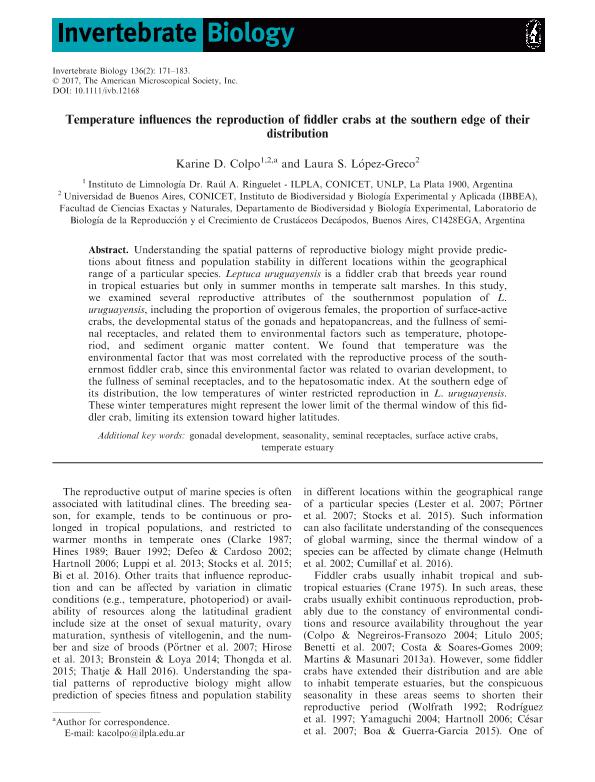Mostrar el registro sencillo del ítem
dc.contributor.author
Delevati Colpo, Karine

dc.contributor.author
Lopez, Laura Susana

dc.date.available
2017-09-15T16:08:44Z
dc.date.issued
2017-05-03
dc.identifier.citation
Delevati Colpo, Karine; Lopez, Laura Susana; Temperature influences the reproduction of fiddler crabs at the southern edge of their distribution; Wiley; Invertebrate Biology; 136; 2; 3-5-2017; 171-183
dc.identifier.issn
1077-8306
dc.identifier.uri
http://hdl.handle.net/11336/24358
dc.description.abstract
Understanding the spatial patterns of reproductive biology might provide predictions about fitness and population stability in different locations within the geographical range of a particular species. Leptuca uruguayensis is a fiddler crab that breeds year round in tropical estuaries but only in summer months in temperate salt marshes. In this study, we examined several reproductive attributes of the southernmost population of L. uruguayensis, including the proportion of ovigerous females, the proportion of surface-active crabs, the developmental status of the gonads and hepatopancreas, and the fullness of seminal receptacles, and related them to environmental factors such as temperature, photoperiod, and sediment organic matter content. We found that temperature was the environmental factor that was most correlated with the reproductive process of the southernmost fiddler crab, since this environmental factor was related to ovarian development, to the fullness of seminal receptacles, and to the hepatosomatic index. At the southern edge of its distribution, the low temperatures of winter restricted reproduction in L. uruguayensis. These winter temperatures might represent the lower limit of the thermal window of this fiddler crab, limiting its extension toward higher latitudes.
dc.format
application/pdf
dc.language.iso
eng
dc.publisher
Wiley

dc.rights
info:eu-repo/semantics/openAccess
dc.rights.uri
https://creativecommons.org/licenses/by-nc-sa/2.5/ar/
dc.subject
Gonadal Development
dc.subject
Seasonality
dc.subject
Seminal Receptacles
dc.subject
Surface Active Crabs
dc.subject
Temperate Estuary
dc.subject.classification
Bioquímica y Biología Molecular

dc.subject.classification
Ciencias Biológicas

dc.subject.classification
CIENCIAS NATURALES Y EXACTAS

dc.title
Temperature influences the reproduction of fiddler crabs at the southern edge of their distribution
dc.type
info:eu-repo/semantics/article
dc.type
info:ar-repo/semantics/artículo
dc.type
info:eu-repo/semantics/publishedVersion
dc.date.updated
2017-09-08T14:31:28Z
dc.journal.volume
136
dc.journal.number
2
dc.journal.pagination
171-183
dc.journal.pais
Estados Unidos

dc.journal.ciudad
Hoboken
dc.description.fil
Fil: Delevati Colpo, Karine. Consejo Nacional de Investigaciones Científicas y Técnicas. Centro Científico Tecnológico Conicet - La Plata. Instituto de Limnología "Dr. Raúl A. Ringuelet". Universidad Nacional de La Plata. Facultad de Ciencias Naturales y Museo. Instituto de Limnología; Argentina. Consejo Nacional de Investigaciones Científicas y Técnicas. Oficina de Coordinación Administrativa Ciudad Universitaria. Instituto de Biodiversidad y Biología Experimental y Aplicada. Universidad de Buenos Aires. Facultad de Ciencias Exactas y Naturales. Instituto de Biodiversidad y Biología Experimental y Aplicada; Argentina
dc.description.fil
Fil: Lopez, Laura Susana. Consejo Nacional de Investigaciones Científicas y Técnicas. Oficina de Coordinación Administrativa Ciudad Universitaria. Instituto de Biodiversidad y Biología Experimental y Aplicada. Universidad de Buenos Aires. Facultad de Ciencias Exactas y Naturales. Instituto de Biodiversidad y Biología Experimental y Aplicada; Argentina
dc.journal.title
Invertebrate Biology

dc.relation.alternativeid
info:eu-repo/semantics/altIdentifier/doi/http://dx.doi.org/10.1111/ivb.12168
dc.relation.alternativeid
info:eu-repo/semantics/altIdentifier/url/http://onlinelibrary.wiley.com/doi/10.1111/ivb.12168/abstract
Archivos asociados
